The mid-1960s were a busy time in the helicopter industry, on both the civil and military sides. In the commercial market, turbine small light helicopters were beginning to make a major impact, where they were replacing piston engine rotorcraft. On the military side, the U.S. was looking for a turbine-powered armed attack helicopter for use in the Vietnam War, where it would be used to protect Piasecki H-21 and Bell UH-1 Huey transport aircraft.
In the summer of 1964, the U.S. Army put out a request for proposals (RFP) for its new Advanced Aerial Fire Support System (AAFSS) program. More than a dozen companies submitted proposals, and bids from two companies — Lockheed Corp. and Sikorsky Aircraft — were eventually declared the winners and moved onto the next round.
Lockheed’s design, called the CL-840 Cheyenne, was for a compound helicopter with a tandem two-man cockpit, a rigid main rotor system, stub wings, a standard tail rotor, and a separate pusher propeller at the back of the fuselage.
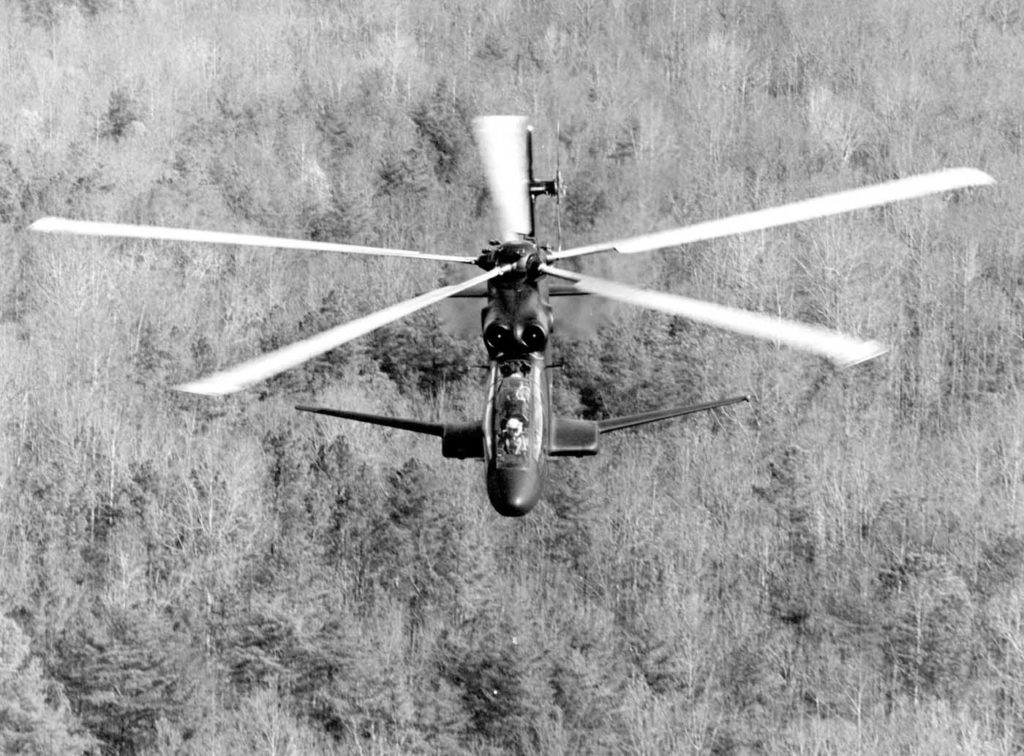
Sikorsky’s proposal, called the S-66, had a conventional main rotor system, a two-man tandem cockpit, stub wings, and a tail rotor on the back called a “Rotoprop.” This unique tail rotor was capable of rotating 90 degrees to act as a pusher prop as the speed of the helicopter increased. Sikorsky felt its design was lighter, simpler and a lower risk solution, while being more stable and agile in flight.
However, in November 1965, the U.S. Army felt the risk with the S-66 program was too high, and declared Lockheed’s Cheyenne the winner of the AAFSS competition. As history would show, the AH-56 ran into development problems of its own, with the Army requesting Lockheed to fix numerous technical problems with the helicopter. Progress in the latter half of the decade was not to the Army’s liking, and in May 1969 it cancelled the production contract.
The loss of the S-66 proposal had been a bitter disappointment for Sikorsky, which had been extremely confident in the type’s design. Sikorsky executives and engineers followed the Cheyenne helicopter development closely, and in mid-1969 began initial studies on an advanced version of a high-speed helicopter gunship, known as the S-67 Blackhawk.

The United Aircraft Corp. funded the development of the new aircraft without the use of any military support, but many S-67 design features were originally formulated for the S-66 program. The design and flight experience with the Sikorsky S-61F compound helicopter, which had wings and auxiliary propulsion, also contributed to the S-67 design.
The S-67 Blackhawk program was approved in January 1970, with John A. McKenna, Sikorsky’s executive vice president, given primary responsibility for the development of the type.
The assignment was to design, build, and fly a helicopter of about 18,000 to 20,000 pounds (8,170 to 9,080 kilograms) gross weight that could reach a speed of about 200 knots (370 km/h) in a shallow dive. The budget was set at about $3 million — and the team had just nine months to do it.
A speedy development
Fabrication of the sole S-67 prototype began in February 1970, and was completed seven months later about $100,000 under budget. The first flight took place on Aug. 20, 1970, at the company’s Stratford, Connecticut, plant. Test pilot Kurt Cannon was very influential in the final design.
“The S-67 is a combination of proven components and new design concepts,” a Sikorsky fact sheet stated. “The result is a new helicopter weapons system at greatly reduced cost and technical risk; high performance, ease of maintenance, and early availability.”
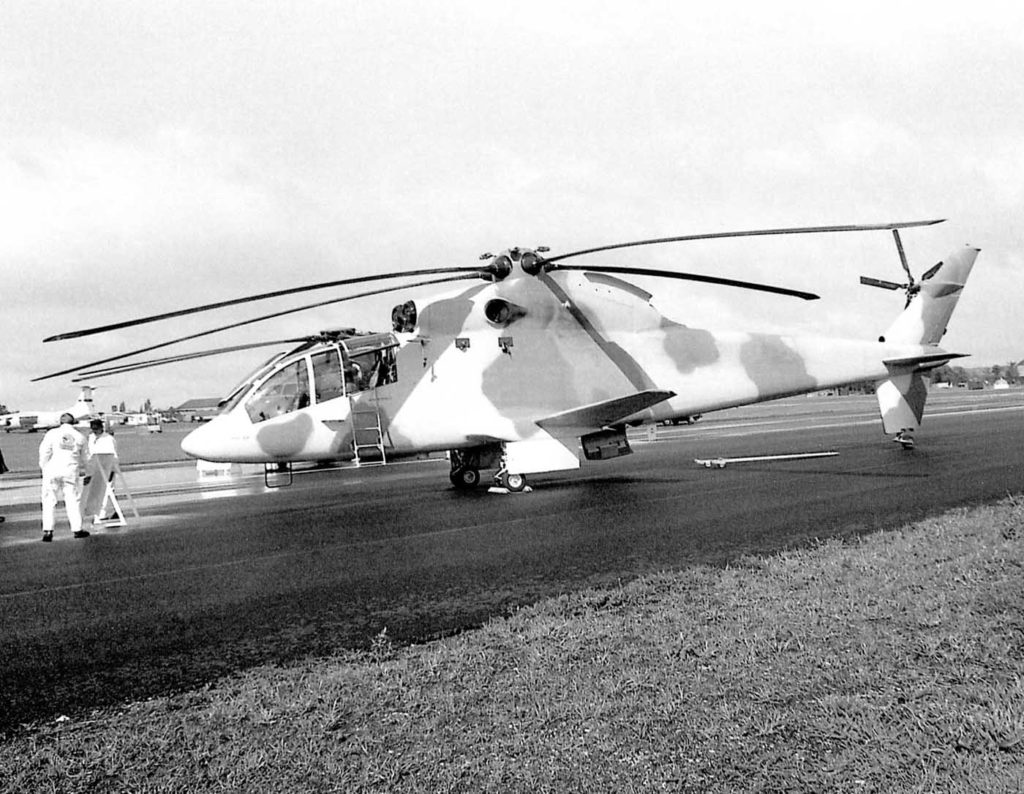
The aircraft had high-speed sweptback blade tips, which were flown to advancing tip speeds of Mach .96 without any adverse compressibility effects during one test.
A large cambered vertical fin provided directional stability that was, to that point, unprecedented in helicopters. The fin began to take over the torque-compensating tail rotor when speeds reached 46 mph (74 km/h). If the tail rotor became inoperable, the Blackhawk could still fly home and land safely.
A controllable horizontal stabilizer (stabilator) reduced rotor stresses in maneuvering flights and allowed the pilot to trim the fuselage independently of the rotor.
Wing-mounted speed brakes, the first on a helicopter, added agility and control during combat maneuvers. The brakes could be open or closed in three seconds and yielded an increase in deceleration of up to 100 percent and a 38 percent steeper dive angle. The brakes, in conjunction with the stability provided by the helicopter’s fin and stabilator, enabled the Blackhawk to hold much steadier on target at all speeds. The speed brakes also gave the helicopter unrivaled maneuverability.
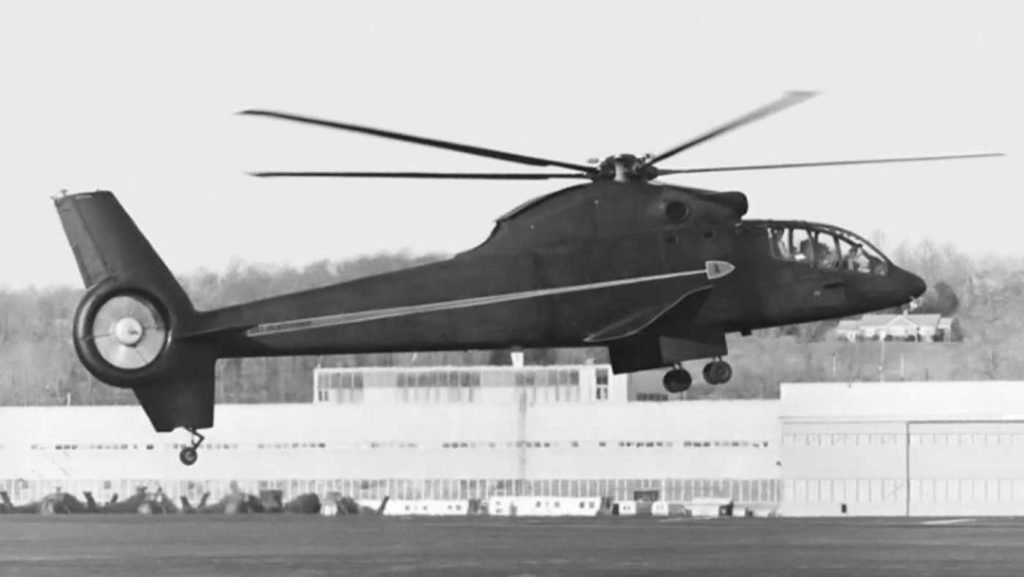
“The S-67 was developed primarily as a high-speed helicopter for direct aerial support, including anti-tank use, but has the potential for other missions such as high speed rescue, high speed troop transport, cargo or weapons carrying, observation and surveillance, and anti-submarine warfare,” stated the Sikorsky fact sheet.
The wing span on the helicopter was 27 feet, four inches (8.3 meters), and it originally had two hard points for weapons, fuel tanks and other armament. An additional hard point was added later. The wings were easily detachable, as they were not an integral part of the helicopter in troop transport and external load missions.
The fuselage was three feet, 10 inches wide (1.2 meters) and 74 feet, one inch long (22.6 meters). Its narrow, low-drag silhouette and design innovations were aimed at new highs in speed, agility and versatility. The S-67 could carry arms and ammunition weighing up to 8,000 lb. (3,632 kg), and it could use existing weapons, such as turret-mounted 7.62 mm guns, 20-and 30-mm cannons, 40-mm grenade launchers, and wing-mounted rockets or TOW missile pods. The gun turret was installed directly under the pilot’s seat.
The pilot and gunner-co-pilot were seated in tandem beneath a single canopy with the pilot seated in the rear. They used standard cyclic and collective controls for flying. The pilot entered the S-67 on the left side with the co-pilot entering the helicopter on the right side.
The S-67 was powered by two General Electric T58-GE-5 1,500 horsepower turbine engines — the same used in the Sikorsky S-61.
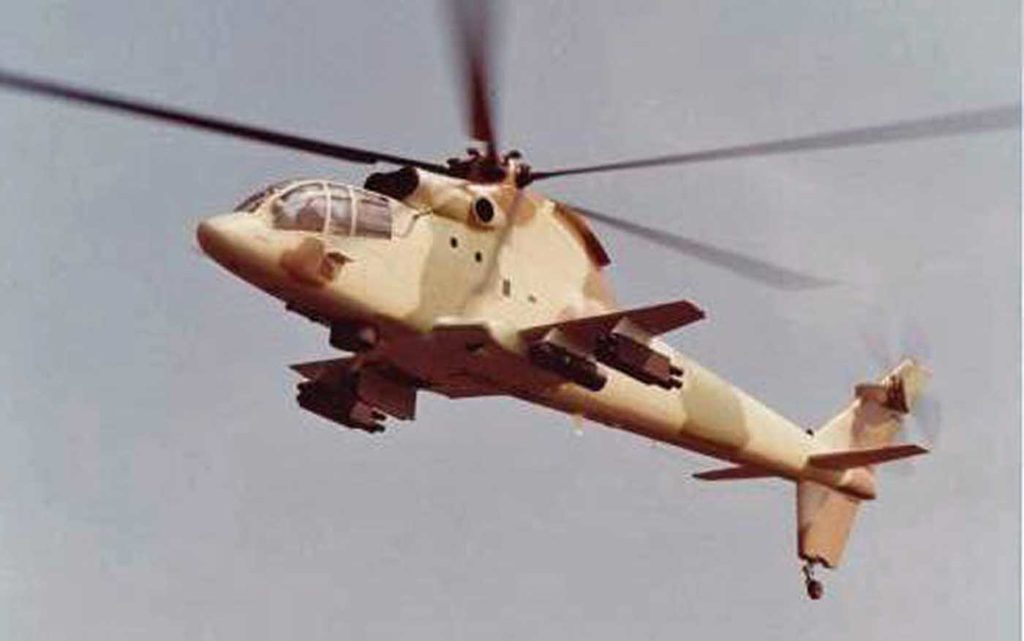
The two front double main wheels retracted into sponsons on the sides of the fuselage. A fixed non-retractable tail wheel was located in the back of the fuselage. The S-67’s landing gear worked well while landing on flat surfaces, but soft uneven terrain could be a problem.
An agile performer
The aircraft soon showed it could perform rolls, loops, and split-S turns with ease. Roll maneuvers were only carried out to the right. Test pilot Cannon with co-pilot Byron Graham established a new absolute speed record, averaging 216.8 mph (348.9 km/h) over a 1.86-mile (three-kilometer) course in December 1970. Five days later, the air crew set a new speed record with the Blackhawk averaging 220.9 mph (355.5 km/h) on a 9.3- to 15.5-mile (15- to 25-kilometer) course. The records would stand for the next eight years.
The S-67 was extensively demonstrated to the U.S. military the following year, as it travelled across the U.S. to more than a dozen bases.
Following the self-funded S-67 test program, Sikorsky was awarded an Army contract to further evaluate the aircraft’s speed brakes, stabilator, aircraft maneuverability and controllability up to the airframe structural limit of 3.3 gs. The testing would also explore “force feel” — an artificial feel system in the controls to give a more airplane-like control system in the forces felt by the pilot.
The U.S. Army Aviation Systems Test Activity conducted an evaluation of the Sikorsky S-67 Blackhawk helicopter to support the Attack Helicopter Requirement Evaluation (AHRE) in mid-1972. The aircraft’s performance, handling qualities, and mission suitability were examined over 26 hours of flight time. In the end, there were 16 handling shortcomings noted. All were deemed fixable, and they did not affect the aircraft’s performance. All told, the Army was pleased with the S-67’s performance qualities, and several Army pilots were checked out on the Blackhawk during the evaluation.
The Army completed further altitude testing of the S-67 in Colorado to provide maximum hot day/high altitude data. This test program determined the flight envelope and demonstrated the suitability of the S-67 for operations in any part of the world.
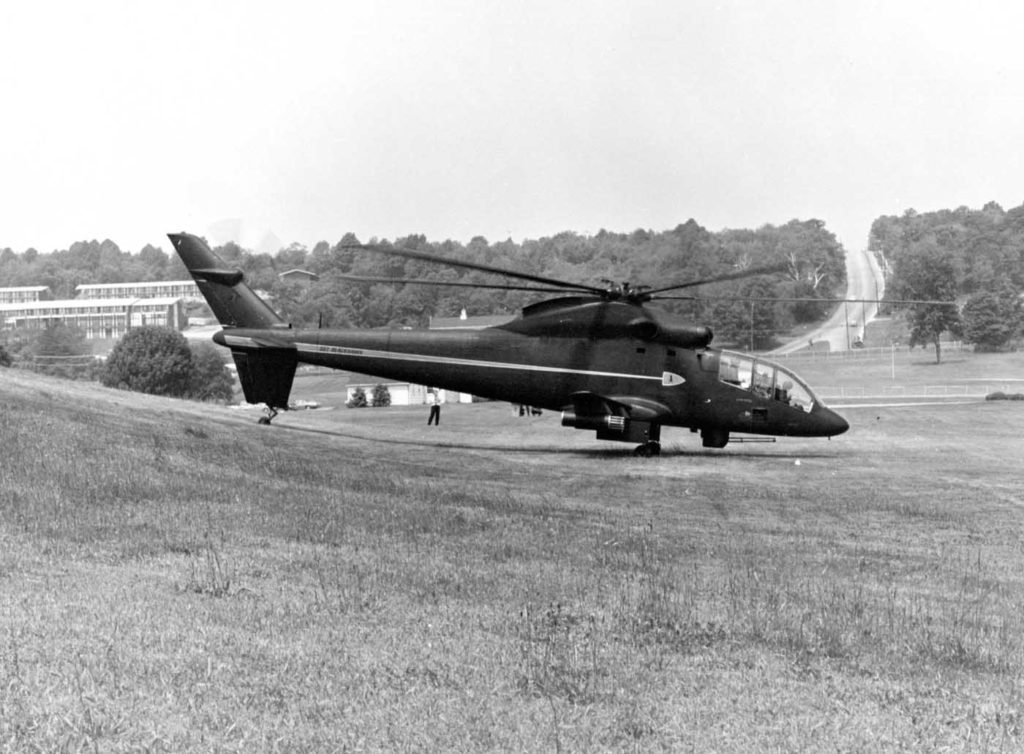
“The S-67 is very maneuverable, I experienced up to 3 gs and could easily bank and turn, split-S, and generally rack it around,” said one high-ranking military pilot. “The visibility is excellent from both cockpits.”
Leaving a legacy
The U.S. Army was looking at both the S-67 and the Bell Model 309 KingCobra as a possible replacement for the troubled AH-56 Cheyenne program, but in the end, neither contender was picked. Eight days after cancelling the Cheyenne program, the Army announced a new Advanced Attack Helicopter (AAH) program, which was won by Hughes Helicopters (now Boeing) with the AH-64 Apache.
After the S-67 completed the Army evaluation, it underwent additional company-sponsored tests to validate the performance of new navigation systems, heads up displays, a projected map, a low light TV and a new turret system. Later airframe upgrades included the addition of rudders on the ventral and dorsal fins to help increase yaw control, and the modification of the compartment behind the pilot to allow the aircraft to carry six passengers/troops. Sikorsky added further hard points to the wings for carrying missiles, and a hook beneath the fuselage to allow it to carry a 7,000-lb. (3,175-kg) external load.
With the lack of interest in the S-67 from the U.S. military, Sikorsky looked overseas for potential export and sales. In late 1972, Sikorsky pilots Graham and John Dixon embarked on a two-month tour of Europe and the Middle East. West Germany, Iran, Greece and Israel were among the countries visited.

During 1974, Sikorsky received a contract from the Eustis Directorate, Army Air Mobility Research and Development Laboratory in Fort Eustis, Virginia, to replace the tail rotor with a modified fan-in-fin concept, manufactured by Hamilton-Standard Company. Installation of the variable pitch, ducted, directional control fan was expected to result in greater reliability, with reduced maintenance. Flight tests included a dive of 230 mph (370 km/h), but after they were completed, the modified tail rotor was changed back to the conventional tail rotor.
In the late summer of 1974, the S-67 was shipped to England on a second European tour, arriving in August at RAF Woodbridge in East Anglia. It was due to fly at the Farnborough Airshow, where it would demonstrate alongside a U.S. Military Sikorsky CH-53. However, tragedy struck during a press preview flight when the S-67 hit the ground during a second right-hand low-level roll. Both pilots were killed and the aircraft was destroyed.
Sikorsky terminated the S-67 Blackhawk program following the loss of the single demonstrator aircraft, but the legacy of the “Blackhawk” name would live on. In 1976, Sikorsky was named the winner of the Army’s Utility Tactical Transport Aircraft System (UTTAS) medium-lift utility helicopter, with its YUH-60A beating Boeing’s YUH-61 aircraft. Sikorsky named its new UH-60 helicopter the Black Hawk.






Spent many hours flight test for handling qualities in this aircraft had a chance to participate and rolls and split S
I was a “test and development technician” at the Stratford plant in the early 1970’s and worked on the blades, rotor, shaft and transmission development for this helicopter. Just wanted to add one important design it incorporated. “Stealth”. When it flew by all of us on the tarmac at the plant it demonstrated it’s ability to get on target without being heard until it was already passing by. The sound was several seconds behind the helicopter which made it able to “hit and run” before the enemy could target it. I was quite impressed and proud of being part of it’s performance as it did hold the world record many years for speed at various configurations, straight, dive, etc.